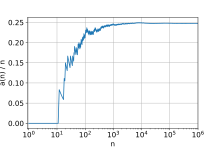过剩数
外观
(重定向自丰数)

在数论中,过剩数又称作丰数或盈数,一般指的是真约数之和大于自身的一类正整数,严格意义上指的是因数和函数大于两倍自身的一类正整数。
定义
[编辑]一般定义
[编辑]一般而言,过剩数是指使得函数 的正整数 ,其中 指的是 的真约数之和; 称作 的盈度或丰度。
例如,12除本身外的所有正约数为1、 2、 3、 4和6,由于 ,且 ,因此12为过剩数,且12的丰度为 。
严格定义
[编辑]更为严格地说,过剩数是指使得函数 的正整数 ,其中 指的是 的所有正因数(包括 )之和; 称作 的盈度或丰度。
在这种定义下,12的正约数有1、 2、 3、 4、 6和12,由于 ,且 ,因此12为过剩数,且12的丰度为 。
性质
[编辑]- 945、 1575、 2205、 2835、 3465、 4095、 4725、 5355、 5775、 5985、 6435、 6615、 6825、 7245、 7425、 7875 ……
- 不能被2和3整除的最小过剩数是 5391411025,其素因数有 5、 7、 11、 13、 17、 19、 23 和 29(OEIS数列A047802)。
- 亚努奇(Iannucci)在2005年给出了一个寻找不能被前个素数整除的最小过剩数的算法[1]:若 表示不能被前 个素数整除的最小过剩数,则当 足够大时,对所有的 ,有
- 除了完全数本身,完全数的倍数都是过剩数[3]。例如,每个大于6之6的倍数都是过剩数,因为 。
- 过剩数的倍数都是过剩数[3]。例如,20是过剩数,20及其倍数也都是过剩数,因为 。
- 由于完全数的倍数都是过剩数,过剩数的倍数也都是过剩数[3],因此奇数和偶数的过剩数都有无限多个。

- 过剩数的集合具有非零的自然密度[4],1998年 Marc Deléglise 证明了过剩数在自然数中的自然密度介于 0.2474 与 0.2480 之间[5]。
- 若一个过剩数不是完全数或其他过剩数的倍数,则这个数称为本原过剩数[6][7]。
- 若一个过剩数的丰度超过所有小于该数的过剩数的丰度,则这个过剩数称为高过剩数。
- 若一个过剩数的相对丰度 超过所有小于该数的过剩数的丰度,则这个过剩数称为超过剩数。
- 每个大于 20161 的整数都可以写成两个过剩数之和[8]。
- 不是半完全数的过剩数称为奇异数[9][2]:144。
- 丰度为1的过剩数称为准完全数,然而目前尚未找到准完全数[10]。
相关概念
[编辑]
- 与过剩数相关的概念是完全数(真约数和等于本身,即 或 )和亏数(真约数和小于本身,即 或 )。最早将自然数分为过剩数、完美数和亏数的是 Nicomachus 于公元前100年所著的 Introductio Arithmetica。
- 的丰度指数(过过剩指数)是指约数和与自身的比,即 [11];若一组相异的数 (无论是否为过剩数)拥有相同的丰度指数,则这些数互为友谊数。
- 记 变化时,满足 的最小自然数 构成数列 (OEIS数列A134716),则 ,为第一个过剩数[12]。 是一个增长速度很快的数列。
- 丰度指数超过3的最小奇数为 [13]。
参见
[编辑]参考文献
[编辑]- ^ D. Iannucci, On the smallest abundant number not divisible by the first k primes, Bulletin of the Belgian Mathematical Society, 2005, 12 (1): 39–44 [2022-09-21], (原始内容存档于2019-04-07)
- ^ 2.0 2.1 Tattersall, James J. Elementary Number Theory in Nine Chapters 2nd. Cambridge University Press. 2005. ISBN 978-0-521-85014-8. Zbl 1071.11002.
- ^ 3.0 3.1 3.2 Tattersall (2005)[2], p.134
- ^ Hall, Richard R.; Tenenbaum, Gérald. Divisors. Cambridge Tracts in Mathematics 90. Cambridge: Cambridge University Press. 1988: 95. ISBN 978-0-521-34056-4. Zbl 0653.10001.
- ^ Deléglise, Marc. Bounds for the density of abundant integers. Experimental Mathematics. 1998, 7 (2): 137–143 [2022-09-21]. CiteSeerX 10.1.1.36.8272
 . ISSN 1058-6458. MR 1677091. Zbl 0923.11127. doi:10.1080/10586458.1998.10504363. (原始内容存档于2020-10-13).
. ISSN 1058-6458. MR 1677091. Zbl 0923.11127. doi:10.1080/10586458.1998.10504363. (原始内容存档于2020-10-13).
- ^ Weisstein, Eric W. (编). Primitive Abundant Number. at MathWorld--A Wolfram Web Resource. Wolfram Research, Inc. (英语).
- ^ Erdős adopts a wider definition that requires a primitive abundant number to be not deficient, but not necessarily abundant (Erdős, Surányi and Guiduli. Topics in the Theory of Numbers p214. Springer 2003.). The Erdős definition allows perfect numbers to be primitive abundant numbers too.
- ^ Sloane, N.J.A. (编). Sequence A048242 (Numbers that are not the sum of two abundant numbers). The On-Line Encyclopedia of Integer Sequences. OEIS Foundation.
- ^ Benkoski, Stan. E2308(in Problems and Solutions). The American Mathematical Monthly. Aug.-September 1972, 79 (7): 774. doi:10.2307/2316276.
- ^ Hagis, Peter; Cohen, Graeme L. Some results concerning quasiperfect numbers. J. Austral. Math. Soc. Ser. A. 1982, 33 (2): 275–286. MR 0668448. doi:10.1017/S1446788700018401.
- ^ Laatsch, Richard. Measuring the abundancy of integers. Mathematics Magazine. 1986, 59 (2): 84–92. ISSN 0025-570X. JSTOR 2690424. MR 0835144. Zbl 0601.10003. doi:10.2307/2690424.
- ^ Sloane, N.J.A. (编). Sequence A134716 (a(n) = least number m such that sigma(m)/m > n). The On-Line Encyclopedia of Integer Sequences. OEIS Foundation.
- ^ Sloane, N.J.A. (编). Sequence A119240 (Least odd number k such that sigma(k)/k >= n.). The On-Line Encyclopedia of Integer Sequences. OEIS Foundation.




































